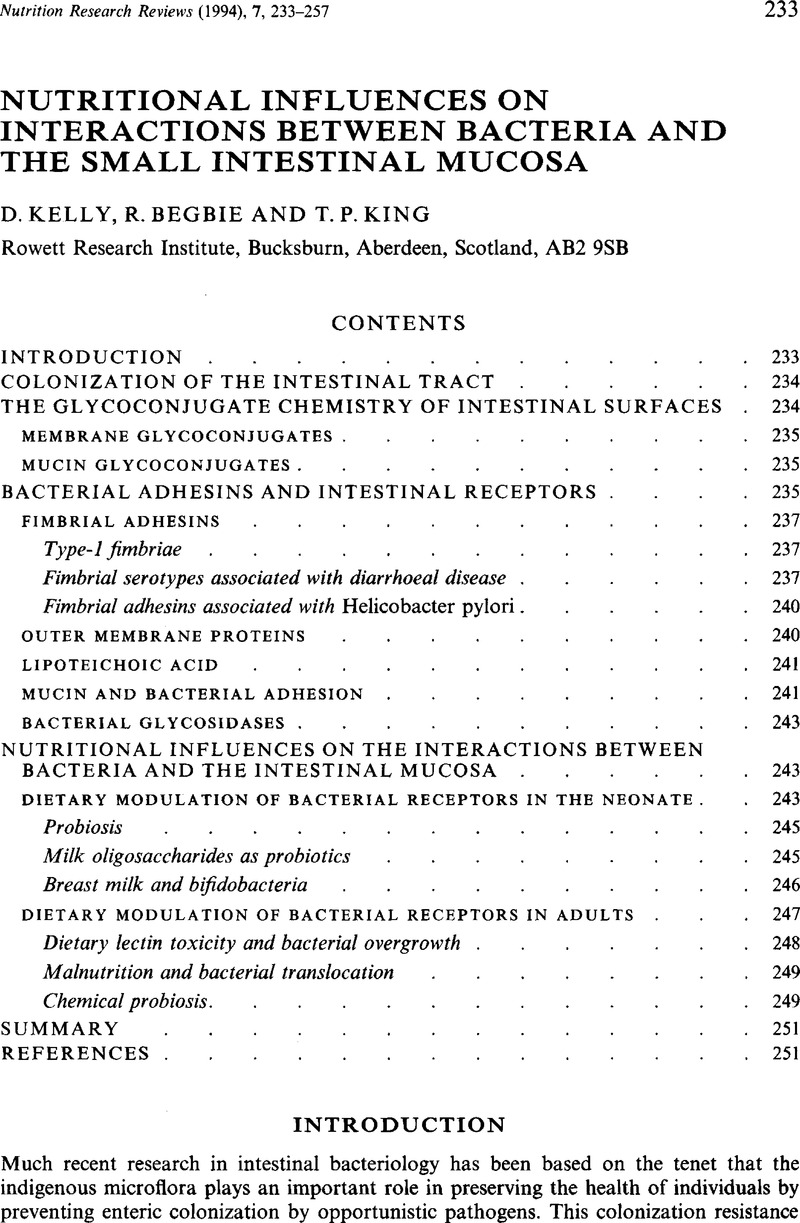Crossref Citations
This article has been cited by the following publications. This list is generated based on data provided by Crossref.
Chandra, Gayatri
Oli, Monika
Petschow, Bryon W.
and
Buddington, Randal K.
1996.
Advances in Swine in Biomedical Research.
p.
769.
Pluske, John R.
Hampson, David J.
and
Williams, Ian H.
1997.
Factors influencing the structure and function of the small intestine in the weaned pig: a review.
Livestock Production Science,
Vol. 51,
Issue. 1-3,
p.
215.
Buddington, Randal K.
and
Weiher, Evan
1999.
The Application of Ecological Principles and Fermentable Fibers to Manage the Gastrointestinal Tract Ecosystem.
The Journal of Nutrition,
Vol. 129,
Issue. 7,
p.
1446S.
Bonneau, M
and
Laarveld, B
1999.
Biotechnology in animal nutrition, physiology and health.
Livestock Production Science,
Vol. 59,
Issue. 2-3,
p.
223.
Muir, W
2000.
Immunity, vaccination and the avian intestinal tract.
Developmental & Comparative Immunology,
Vol. 24,
Issue. 2-3,
p.
325.
Erik, Knud
and
Knudsen, Bach
2001.
Development of antibiotic resistance and options to replace antimicrobials in animal diets.
Proceedings of the Nutrition Society,
Vol. 60,
Issue. 3,
p.
291.
Pluske, John R
Pethick, David W
Hopwood, Deborah E
and
Hampson, David J
2002.
Nutritional influences on some major enteric bacterial diseases of pig.
Nutrition Research Reviews,
Vol. 15,
Issue. 2,
p.
333.
2002.
Editorial.
Nutrition Research Reviews,
Vol. 15,
Issue. 2,
p.
207.
Montagne, L.
Piel, C.
and
Lalles, J.P.
2004.
Effect of Diet on Mucin Kinetics and Composition: Nutrition and Health Implications.
Nutrition Reviews,
Vol. 62,
Issue. 3,
p.
105.
Fairbrother, John M.
Nadeau, Éric
and
Gyles, Carlton L.
2005.
Escherichia coliin postweaning diarrhea in pigs: an update on bacterial types, pathogenesis, and prevention strategies.
Animal Health Research Reviews,
Vol. 6,
Issue. 1,
p.
17.
O'Connell, J. M.
Callan, J. J.
and
O'Doherty, J. V.
2005.
The interaction between cereal type and lactose level on piglet performance and diet digestibility post weaning.
Animal Science,
Vol. 81,
Issue. 2,
p.
265.
Lesniewska, Violetta
Rowland, Ian
Cani, Patrice D.
Neyrinck, Audrey M.
Delzenne, Nathalie M.
and
Naughton, Patrick J.
2006.
Effect on Components of the Intestinal Microflora and Plasma Neuropeptide Levels of Feeding
Lactobacillus delbrueckii
,
Bifidobacterium lactis
, and Inulin to Adult and Elderly Rats
.
Applied and Environmental Microbiology,
Vol. 72,
Issue. 10,
p.
6533.
Gyawali, Rabin
and
Ibrahim, Salam A.
2012.
Impact of plant derivatives on the growth of foodborne pathogens and the functionality of probiotics.
Applied Microbiology and Biotechnology,
Vol. 95,
Issue. 1,
p.
29.
Liu, Xiaolu
Yan, Hai
Lv, Le
Xu, Qianqian
Yin, Chunhua
Zhang, Keyi
Wang, Pei
and
Hu, Jiye
2012.
Growth Performance and Meat Quality of Broiler Chickens Supplemented with Bacillus licheniformis in Drinking Water.
Asian-Australasian Journal of Animal Sciences,
Vol. 25,
Issue. 5,
p.
682.
Bach Knudsen, Knud Erik
Hedemann, Mette Skou
and
Lærke, Helle Nygaard
2012.
The role of carbohydrates in intestinal health of pigs.
Animal Feed Science and Technology,
Vol. 173,
Issue. 1-2,
p.
41.
Xiao, R.
Power, R.F.
Mallonee, D.
Routt, K.
Spangler, L.
Pescatore, A.J.
Cantor, A.H.
Ao, T.
Pierce, J.L.
and
Dawson, K.A.
2012.
Effects of yeast cell wall-derived mannan-oligosaccharides on jejunal gene expression in young broiler chickens.
Poultry Science,
Vol. 91,
Issue. 7,
p.
1660.
Styková, E.
Nemcová, R.
Valocký, I.
Novotný, F.
and
Guba, P.
2013.
Adherence of bacteria to mucus collected from different parts of the reproductive tract of heifers and cows.
Canadian Journal of Microbiology,
Vol. 59,
Issue. 11,
p.
720.
Schedle, Karl
2016.
Sustainable pig and poultry nutrition by improvement of nutrient utilisation – A review.
Die Bodenkultur: Journal of Land Management, Food and Environment,
Vol. 67,
Issue. 1,
p.
45.
Gutiérrez, Sergio
Morán, Alfredo
Martínez-Blanco, Honorina
Ferrero, Miguel A.
and
Rodríguez-Aparicio, Leandro B.
2017.
The Usefulness of Non-Toxic Plant Metabolites in the Control of Bacterial Proliferation.
Probiotics and Antimicrobial Proteins,
Vol. 9,
Issue. 3,
p.
323.
Ogunade, Ibukun
Jiang, Yun
Adeyemi, James
Oliveira, Andre
Vyas, Diwakar
and
Adesogan, Adegbola
2018.
Biomarker of Aflatoxin Ingestion: 1H NMR-Based Plasma Metabolomics of Dairy Cows Fed Aflatoxin B1 with or without Sequestering Agents.
Toxins,
Vol. 10,
Issue. 12,
p.
545.





